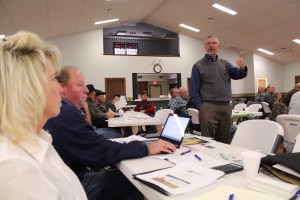KIDRON, Ohio — Dairy farmers have a lot of choices for protecting themselves against risk and financial loss, thanks to the new farm bill.
Those choices were the focus of this year’s annual Ohio Dairy Producers Association fall meetings, held Nov. 5 in Mercer County, and Nov. 6 in Kidron.
Two of the main choices include the dairy Margin Protection Program (MPP), and the Livestock Gross Margin (LGM) insurance for dairy.
The MPP works by ensuring participating farmers a pre-determined percentage of a pre-determined production margin. At its most basic level, MPC costs farmers $100 a year to participate and ensures them a $4 production margin (the sale of milk minus feed costs).
Producers may also “buy-up coverage” that provides payments when margins are as high as $8 per hundredweight. The producer must pay a premium that corresponds with the level of protection the producer chooses.
Percent of protection
When farmers register to participate in the program, they will also decide which level of production history they want to protect, from 25 to 90 percent. The basic, $4 margin includes a 90 percent coverage, but if they choose more, they will pay additional premiums based on the percentage of coverage they want.
The Livestock Gross Margin provides insurance protection against the loss of gross margin (market value of milk minus feed costs) on milk produced from dairy cattle.
The LGM program is similar to MPP, but is fully customizable. LGM uses the Chicago Mercantile Exchange Group futures prices for corn, soybean meal and Class III milk, to determine the expected gross margin, and the actual gross margin.

An indemnity is paid if actual gross margin is less than the guarantee.
LGM premiums depend on producers’ marketing plan, deductible level, futures and price volatility.
Farmers can use both programs, but not simultaneously.
Expert speakers
The meetings were led by Cam Thraen, an Ohio State University dairy marketing and policy specialist, and Brad Sharp, a risk management specialist with Diversified Services.
While dairy prices have been strong for the past year or two, both men cautioned that there are indications of a declining milk price, especially by mid- to late 2015. Programs like MPP and LGM can help farmers survive some of the volatility that may be in store.
Thraen noted, however, that lower milk prices does not necessarily mean a lower profit margin — because while milk prices are coming down — so is the cost of feed.
“The feed price side of the MPP margin has experienced an even greater decline with record grain harvest in the U.S.,” Thraen wrote, in a report prepared for the meeting.
According to Thraen’s most recent analysis, the futures market prices as of Oct. 24 would indicate the milk margin would stay above $9 per cwt. — for the next 15 months — an important factor in determining whether a farmer would see any gain from the program.
According to Sharp, the national average price for corn in 2012 was $6.89 per bushel, more than double the price of what it is this year, at $3.38. Similarly, the soybean price has fallen from $14.30 per bu. to $11.20 per bushel.
Managing risk
As Sharp put it, “What goes up must come down,” but when and how much the markets come down is hard to determine.
Farmers have until Dec. 5 to sign-up for MPP in 2014 and 2015, but there will be additional sign-up opportunities if they choose to wait until a later coverage year. With the LGM program, farmers can sign up on a monthly basis, or 12 times per year.
Thraen said these programs give producers new ways to manage risk, which is ever-volatile in today’s global markets.
“The markets are turbulent,” he said. “You never know what’s going to come.”
Stay vocal
During lunch, ODPA Executive Director Scott Higgins gave an update on the issues the association is currently facing. Those include water quality issues, manure management issues and legislation, and the ever-present need for dairy farmers to market their story and defend the truth.
Higgins is also president and CEO of American Dairy Association Mideast. He encouraged producers to get involved with ODPA, and with social media, so dairy farmers’ voices are heard.
He said there are many conversations taking place within social media — conversations that need farmers’ voices.
“We have to engage at the level where we can to try to dispute negative messages and call the facts out,” he said, adding that “consumer confidence is absolutely essential.”
Learn more:
• Ohio State University dairy policy expert Cam Thraen continues to monitor the margin protection policy and provides his own forecast on what margins might be. To receive this forecast, send an email to thraen.1@osu.edu, and type “MPP Table Request” in the subject line.
• You can follow the dairy markets and policy margin forecast on the DMaP website at www.dairymarkets.org/mpp/.
• To learn more about the Livestock Gross Margin dairy insurance program, visit http://www.rma.usda.gov/pubs/rme/lgmdairy.pdf.











